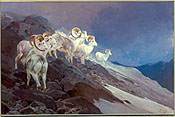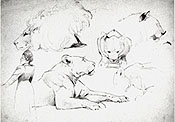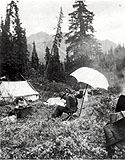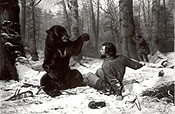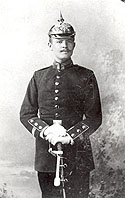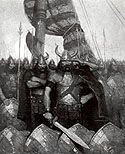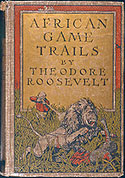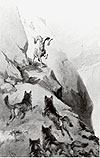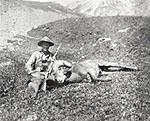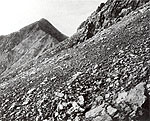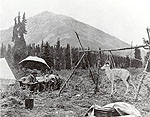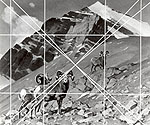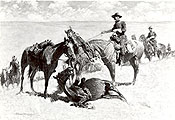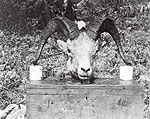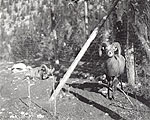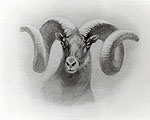The browser will either open the file, download it, or display a dialog.
|
|
Haunted Supermasculinity: Strength and Death in Carl Rungius's Wary Game |
|||||
|
Animal art from the turn of the century seems to be literal and even banal, the kind of picture that neither demands nor rewards close critical inspection. Take for example Carl Rungius's Wary Game, painted about 1908, an image of six mountain rams looking and listening for something to their right. (fig. 1) Admirers of the painting have found it to be an objective view of a creature known as Dall sheep. Detractors might see it, at most, as a forgettable relic of the turn-of-the-century practice and ideology of big-game hunting. Yet Wary Game turns out to be far more complicated—specifically, it casts the rams in racial terms. The painting is a fantasy about the first white "men," primordial and strong, poised on a dizzying peak of virility. Yet at the same time it shows these supermasculine figures standing decrepit, pathetic, and forlorn in their very supremacy—dead in their very life. Wary Game suggests that we miss a great deal when we label comparable turn-of-the-century images as "mere" animal art lacking depth and ideological complexity. | |||||
| The Origins of Whiteness Rungius (pronounced RUN-gis; 1869–1959) based Wary Game on his experiences in the Yukon Territory in the summer of 1904. The Yukon trip came only seven years after the artist had moved to the United States from his native Germany, where he had trained as a painter of both human and animal figures. Rungius explored the Yukon with the hunter Charles Sheldon, who organized the trip, and the naturalist Wilfred Osgood, of the Division of Biological Survey, an arm of the U.S. Department of Agriculture. Sheldon's purpose in traveling to the remote region was to hunt and study the area's mountain sheep. He wanted to determine if the different colors of the Pacific Northwest's alleged three species—Dall sheep, Fannin sheep, and Stone sheep (respectively white, gray, and dark gray) —really did indicate separate types of animal or merely color phases of the same kind of creature. He eventually published his findings, along with a detailed account of the trip, in The Wilderness of the Upper Yukon (1911), a book that mentions Rungius and includes reproductions of several Rungius paintings like Wary Game. |
||||||
| Sheldon's answer to the "perplexing problems" of sheep coloration was racial. Specifically, it reveals his interest in the formation of races. He dismissed the idea of color phases, and he also respectfully rejected the idea of natural selection, as it was espoused in the camouflage theory of Abbott Thayer. (Thayer's magnum opus, Concealing—Coloration in the Animal Kingdom, had just appeared in 1909.) For Sheldon, the different colors of mountain sheep did not make sense as a mode of concealment. Instead, he argued that all the sheep "came from a common ancestor." This ancestor, he felt, was a dark animal—one could tell because even the whitest of the sheep still showed "the persistence of dark hairs" as a residuum of its ancestry. At some point in the past, according to Sheldon, various descendants from this original dark animal had staked out different mountain ranges in Alaska and British Columbia. Partly for environmental reasons (Sheldon is vague about this), the northernmost of these sheep had become whiter while the more southerly ones, those inhabiting British Columbia, had remained comparatively dark. "As a result," Sheldon wrote, "geographical races are formed, gradually changing from one area to another, until the extremes may be widely different."1 | ||||||
| A monogenist theory such as Sheldon's was the only one available to an evolutionist. In the mid-nineteenth century, polygenists had sanctioned racism by theorizing that white— and dark—skinned people had evolved from separate ancestors. After Darwin, however, such a view ceased to be tenable, yet the racism remained. "The polygenists now admitted a common ancestry in the prehistoric mists," writes Stephen Jay Gould, "but affirmed that races had been separate long enough to evolve major inherited differences in talent and intelligence." Gould then quotes the historian George Stocking on the post-1859 "'comprehensive evolutionism which was at once monogenist and racist, which affirmed human unity even as it relegated the dark-skinned savage to a status very near the ape.'"2 Sheldon's monogenism— "admitting a common ancestry in the prehistoric mists," yet still sharply differentiating between black and white creatures—exemplified this racialized view of origins. | ||||||
| In the evolutionary laboratory of the Yukon, one "race" not surprisingly fascinated Sheldon. About the Dall sheep of the Mackenzie Range, he wrote, "All these sheep . . . are pure white" (Sheldon's emphasis). Indeed, a little later, the phrase "pure white" occurs four more times within half a page as Sheldon summarizes his color explanation: "All the sheep of Alaska are uniformly pure white. . . . Throughout the Mackenzie Rockies . . . sheep are pure white. . . . In the Yukon Territory, all sheep . . . are pure white. Pure white sheep greatly preponderate west of the Lewes and Yukon Rivers." That the phrase "pure white" had a vivid racial connotation for Sheldon is clear if we consider that he named the expedition's all-black pack horse "Nigger."3 To study Dall sheep, then, was to see how a white race had evolved. The fact that the creatures were not literally pure white only made them more interesting, since scatterings of dark hairs revealed the animal's evolutionary past. | ||||||
| Wary Game embodies Sheldon's theory of racial evolution in two ways. First, the group of more or less white rams, all of them Dall sheep, illustrates the idea of a white race apart: "Within the geographical areas, the differing characters are sufficiently uniform to mark a race, though there may be individual variation." Second, Rungius's painting also shows Sheldon's idea of the evolutionary development of whiteness from darkness through the influence of Eadweard Muybridge's sequential photography, which had a profound effect on many turn-of-the-century realist pictures. The painting, in Muybridgean fashion, reads as an image not just of six rams but of one ram, seen (from left to right) at six different moments. Though we can read each creature discretely, the sense of separate animals is substantially reduced by the way they blur into one another. As in Muybridge's photographs, Wary Game shows a single figure repeatedly, each figure depicted as part of a temporal sequence.4 | ||||||
| This progression, moreover, illustrates Sheldon's theory of the evolutionary development of whiteness. The nearest, darkest ram reveals Sheldon's opinion about the residual coloration of white rams: "The dark hairs are most persistent in the tail and least persistent in the head and neck. Next they are most persistent on the mid-dorsal line directly above the tail; next on the back."5 As we follow the rams from foreground to midground, however, they become whiter and whiter until we reach the rightmost and most distant ram, brightly illumined by the sun, who seems whitest of all. The successive figures thus show not just the sequential instant, the slight shuffling of one animal in a few seconds, but rather a great evolutionary unfolding, an epochal sort of change. To be more precise, it is an epochal change represented in terms of the sequential instant, as though thousands of years were condensed into a Muybridgean second or two—all so that we can see the progressive shift to whiteness that Sheldon espoused. | ||||||
| The very position of the rams in Wary Game confirms the painting's racial view. Carefully placing the leftmost rams against the dark rocks and the rightmost rams against the dark sky, Rungius chooses not to show any of the white animals against snow. The image clearly forsakes the idea of "concealing-coloration" —an idea that would offer a less racialized explanation of the rams' color. Far from an objective picture, Wary Game represents a monogenist view in which color is explicable as a racial development. | ||||||
| But the painting suggests something else. The satyrlike hybridity of the rams' bodies, especially that of the nearest creature, tantalizingly evokes the human form. (fig. 2) Shown backside first, the nearest animal is the most bestial of all six rams, but the foreshortening of the figure largely defeats its animal horizontality. With the possible exception of the almost obscured ram third from the right, this nearest creature is the only one whose horizontality has been so de-emphasized. The figure thus reads vertically—from its lower hind legs through its backside to its raised neck and head. Also, the fact that this creature, alone among the six, positions its body upward—the front legs on a higher plane than the lower ones—adds to our sense of its vertical orientation. The result is an animal that relates more to the verticality of the human body than to the horizontality of an animal's. | ||||||
| Moreover, Rungius presents the head and neck of the two closest rams in carefully modeled, contoured profiles that invite comparison to human features. One of the many drawings the artist made at the Berlin Zoo in the early 1890s shows the artist's interest in relating animal and human faces. (fig. 3) The image features five views of a lion and lioness, as well as the likeness of a single female zoo visitor. Rungius rhymes the woman's slanting profile with that of the lion directly above her. The repeated profiles show that Rungius could represent human and animal faces in relation. This same interchangeability, it would appear, informs the strange, jut-jawed protohuman profiles of the two nearest rams in Wary Game, as though Rungius meant his viewers to speculate that the rams' faces might bear the physiognomic traces of a nascent humanity. | ||||||
| There is yet a further dimension to the protohumanity of the rams. A photograph from the Yukon trip, taken by Wilfred Osgood, shows Rungius sketching the severed head of a Dall ram like the ones pictured in Wary Game. (fig. 4) What is most interesting about the photograph is the way it persistently relates human and animal. Rungius and the ram's head confront one another. They do so at almost the same level—the artist's head is only slightly higher than the ram's. They are visually matched: the V-shaped spring of the ram's horns duplicates the V-shape of the artist's suspenders. The beast is a strange mirror image of the hunter-artist. The result is a powerful force field of relation traversing the space between them. Osgood's photograph exemplifies the well-known idea of the identity of the hunter and hunted, what the philosopher José Ortega y Gasset called the hunter's "mystical union" with the animal.6 | ||||||
| More precisely, Osgood's photograph is an example of the psychological hunting image. In these images (and stories), the animal becomes an alter ego, a projection of the hunter onto the creature he pursues. The animal becomes a projection of the hunter's primitive or bestial side, so that to hunt the beast is really a symbolic attempt to vanquish or just to see the unruly brute within oneself. In Arthur Fitzwilliam Tait's The Life of a Hunter: A Tight Fix, painted in 1858 (fig. 5), bear and hunter face one another in an extraordinary series of doublings: the bear's fur and the man's hair and beard; the bear's right hind paw and the man's left hand; and the bear's white chest markings and the snow on the man's jacket. The bear, in this sense, is the hunter's second self. Jaw set, the hunter tries to kill his snarling mirror image. Osgood's photograph, representing the same doubling between hunter and prey, comparably casts the ram as Rungius's alter ego. | ||||||
| Osgood's image, thus, epitomizes the mirrorings one finds throughout nineteenth- and early-twentieth-century hunting narratives. In Mary Shelley's Frankenstein (1818), Frankenstein strives to kill the monster he has created—a monster whose extraordinary violence embodies the doctor's own antisocial impulses. In Herman Melville's Moby Dick (1851), Captain Ahab obsessively hunts the white whale whose malevolence evokes his own blind hatred. In "The Jolly Corner" (1906), Henry James's supernatural story masterfully appropriated from the conventions of hunting narratives, a fifty-six-year-old expatriate, Spencer Brydon, returns to Manhattan and begins a strange stalk inside the house in which he grew up. Brydon's quarry is his other self, the person he would have become had he remained in New York and become a businessman. When Brydon finally comes face to face with his prey, he confronts a presence "rigid and conscious, spectral yet human, a man of his own substance and stature." He has finally seen that "strange alter ego" (James's emphasis) he has sought. As Brydon's companion, Alice Staverton, puts it, using words that also apply to Osgood's photograph of Rungius: "You came to yourself."7 | ||||||
| Wary Game explicitly shows no hunter, but the sense of the rams as alter egos is pervasive. Their fixed positions implicitly duplicate the frozen attitude of the unseen hunter suggested by the title. Their vigilant gazes evoke the hunter's concentrated vision. Their virile power—standing, staring, possessed of jutting armaments—parallels that of the gun-toting hunters in photographs taken during the Yukon trip. Much more fundamentally, the rams' physiognomy, as we have seen, is represented on a continuum with the human body. As befits an image made in a Darwinian age, Rungius's painting is a fantasy in which we are meant to discover ourselves, as we existed ages and ages before, at the border, when animal had just begun to change into human. The same is true in Osgood's photograph. Seated before the ram's head, Rungius encounters a first, animal version of himself in which early humanity is just perceptible. | ||||||
| Prehistoric Prussians We can be more specific, though, about what kind of ancestral self Wary Game represents. At the time he painted Wary Game, Rungius was living in Brooklyn, but he and his wife, Louise, maintained strong ties to Germany, her native country also. Germany had been unified only in 1871 (two years after Carl's birth). Not surprisingly, German nationalism characterizes various Rungius family documents. In 1907, three years after Carl had returned from the Yukon, Louise completed a distinctly nationalistic master's thesis at Columbia University entitled "Lessing and Pseudo-Classicism." Her thesis argues that the German theorist Gotthold Ephraim Lessing heroically overturned the "pseudo-classicism" of French writers such as Voltaire and Corneille by adhering to Aristotle's rules about unity of time and place. Lessing restored classical form to German drama and set the stage for the great German writers to follow—Herder, Goethe, and Schiller—so that, in her words, "[N]ow, when France is on the decline, Germany is steadily rising and reaches its highest pinnacle." Lessing's heroic accomplishment— "A radical method . . . to free the Germans from their bondage [to French pseudoclassicism]" —produced an "awakening of a feeling of nationality and pride in Germany." To this last sentence someone, perhaps her advisor, Professor Brander Matthews, felt it necessary to pencil in the word "literary" before the word "Germany." |
||||||
|
Moreover, the nationalism in the Rungius household was distinctly militaristic. In Louise Rungius's thesis, one can sense the Franco-Prussian War of 1870–71, in which Germany defeated France and annexed the province of Alsace-Lorraine. The militarism became more intense in subsequent years. In September 1914, Louise was in Germany just as the war began. Hastily, she returned to New York via Liverpool, traveling steerage on the Lusitania, which the Germans would sink the following year. From Brooklyn Louise wrote to Carl, who was then hunting and painting in Alberta:
Although there is no record of Carl Rungius's reply, it is likely that he shared her views. Carl and his siblings were raised in a fervently nationalistic atmosphere. In a spoken memoir in 1962, near the end of her life, Carl's sister Lise remembered that "In church prayers were officially offered every Sunday for the protection of our 'Kaiser and the entire German war-might on land and on sea,'" and that "Our school and song books were full of material in praise of God and our country, especially Prussia, being the best country and having a way of life superior to any other country anywhere." On the Kaiser's birthday, on January 27, she remembered, there would be no school "but we had to be present for a celebration in the Auditorium to hear patriotic speeches and recitations from the podium, delivered by some girls particularly gifted in that direction. All songs and poems fairly bristled with blood and killing, with praise of our heroes and their 'blessed sword' and with hatred of the cowardly enemy." |
||||||
|
Lise recalled that soldiers were everywhere in and around the Rungius household. "In Germany at that time much of public and private interest centered around our Army… Almost every family had their sons in service, either temporarily or permanently. We were proud of this and felt it to be a great protection." The Rungius family housed staff officers at their home and often saw soldiers on the road from Berlin, which ran right past their house. Carl, a soldier in the German Imperial Army, was in the middle of this militaristic culture. (fig. 6) Lise remembered that he used to call the three talented artists in the family—himself, Lise, and another sister named Luse— "the Holy Alliance." "He of course was Germany, Luse was Austria, and I had to be Italy."9 | |||||
| In light of the nationalism governing Rungius's youth and time in Brooklyn, the Germanic strains of Wary Game become palpable. Louise Rungius's nationalistic statement in her thesis that "Germany is steadily rising and reach[ing] its highest pinnacle," aptly describes Rungius's image of six heroic warriors. Between Rungius's spiked soldier's helmet and the rams' sprouting horns, one suspects, there is little difference. The rams are just more extravagantly armed specimens of Germanic military masculinity. In evolutionary terms, the rams' horns expose the spike on the fusilier's helmet as the vestigial stump of animality. The rams read as imaginary icons of a primordial German soldiery, even of the first "Germans," just at the boundary of humans and animals, figures still in full possession of their raw animal power. As alter egos, the creatures represent the modern soldier's inner barbarian, the noble warlord he used to be. | ||||||
| Other period accounts of primitive Teutonic warriors underscore the kind of ancestral alter ego shown in Wary Game. Although these accounts were not written by Germans, and although they even exemplify an anti-German viewpoint, they explore the same themes as Rungius's picture and reveal him to be working within a larger discourse on this subject. In 1910 N. C. Wyeth painted The First Cargo (fig. 7), an illustration for Arthur Conan Doyle's story of the same name. The story, concerning the fourth-century arrival of Saxons in Britain, was the second installment of "Through the Mists," a three-part tale Doyle published in Scribner's in late 1910 and early 1911 concerning late Roman Europe. Wyeth's picture represents the "warlike Germans," as Doyle describes the Saxons, just after they have disembarked. The ox-horn helmets in Wyeth's painting establish the quasi-animality of the Saxons. | ||||||
| Yet a still baser form of Germanic military masculinity—one closer to the kind Rungius visualized in Wary Game—can be found in Wyeth's illustration for "The Coming of the Huns," the first installment of "Through the Mists." (fig. 8) Wyeth's image shows the animal—Teutons described by Doyle's narrator: "strange humped figures . . . face[s] advanced . . . round-backed." Unlike the Saxons, the Huns crouch over. The verticality of the Saxons, for all their primitiveness, marks their comparatively higher civilization. Each of Wyeth's Huns, by contrast, illustrates the words of Doyle's narrator: "He was a very short, thick man . . . . His legs were short and very bandy, so that he waddled uncouthly as he walked."10 These primitive human figures, tending toward but not quite achieving the vertical, call to mind the rams in Wary Game, with their similar mixture of human and animal orientation. | ||||||
| The profile views in each painting further link Wyeth's and Rungius's images of the Germanic primitive. Wyeth is careful to reveal a profile of the prominent Hun on the left, likely in order to reveal the flattened animal nose of that figure—a nose that emphasizes, as much as the figures' hunched postures, the Huns' low evolutionary state. The profile of Wyeth's Hun suggests the racial import, ca. 1910, of this particular view of the human face—the way the profile could be used, as in the anthropometric photography of Bertillon and Galton, to document the racial characteristics of supposedly lower and higher orders of humanity. In Wary Game, accordingly, Rungius's choice to emphasize the profiles of the two nearest rams serves a similar purpose. Inasmuch as the side view had more ethnographic than zoological connotations, the profiles not only humanize the creatures but also cast them as primitives. Overall, the similarities between Wyeth's and Rungius's images suggest that each artist, operating independently, was concerned with the same pictorial challenge: namely, how to portray a tribe of primitive or animal-Teutons. Whereas Wyeth had to suggest the animal within the white man, Rungius tried to evoke the white man within the animal. | ||||||
| A third image of the Teutonic animal helps illustrate the sense of Rungius's Germanic ram as an alter ego. In Harvey Dunn's illustration for Jack London's story, "When the World Was Young" (1910), a modern man shines a flashlight on a bearded barbarian. The modern man is actually a thief, Dave Slotter, intent upon stealing from the vast country estate of wealthy businessman James Ward. As he walks Ward's grounds, however, Slotter stumbles upon a strange wild man and is forced to flee for his life. Little does Slotter suspect that the barbarian is Ward, who, as London's narrator says, "was two men, and chronologically speaking, these men were several thousand years or so apart." One of Ward's selves is modern, the other a "Teutonic barbarian." By day Ward works in a San Francisco firm, where he is senior partner; as night comes on, he becomes "an uncouth, wife-stealing savage of the dark German forests," "a vagabond anachronism," "a crude, rude savage creature who, by some freak of chance, lived again after thrice a thousand years," a man of extraordinary strength. Ward is even aware of this older self during daylight hours, so much so that in college he had sung ancient Saxon chants for his startled philology professor: "Professor Wertz proclaimed it no hog-German, but early German, or early Teuton, of a date that must far precede anything that had ever been discovered and handed down by the scholars." | ||||||
| In his illustration to London's story, Dunn has cleverly made the thief's encounter with Ward's Teutonic self into an image of Ward's own divided nature. His head at the same height, his legs and hands positioned similarly, his body facing the other, the barbarian mirrors the man in the derby hat, perfectly illustrating the words of London's narrator about Ward: "half of him was late American and the other half early Teuton."11 | ||||||
| Dunn's image strikingly matches the mirroring dynamics of Osgood's photograph, reinforcing our sense of the ram as Rungius's own Teutonic double. Moreover, Dunn's image, like London's story, helps us to see that Wary Game itself represents a comparable fantasy: the modern man seeing himself at a remote evolutionary epoch, as he used to be, a prognathous Prussian, a first white man, " a crude, rude savage" in a state of indomitable command. | ||||||
| White and Black And in a pristine new world. As a sharp contrast to the polyglot world of Brooklyn, where Rungius made the painting, Wary Game envisions a Teutonic arrival in an untouched land. Charles Sheldon believed that the first rams emigrated from Asia. As the novelist Owen Wister wrote in 1904, the mountain ram "had at some period of his long, long ancestry marched across to us from Asia upon his lengthy un-sheeplike legs—skipped over the icy straits before Adam (let alone Behring [sic]) was in the world." Though of course the rams in Wary Game have not literally just emigrated, Rungius uses the visual conventions of the Heroic Arrival in order to show them as stalwart newcomers looking out on an empty land. He presents them in the manner of pilgrims, surveying an untouched world of promise. In this respect, Rungius's rams, like Doyle's Saxons, are themselves a "first cargo." The way to deal with the heterodox present is to think back to the first moments of a white race on the North American continent. To adapt the words of cultural historian Donna Haraway about the American Museum of Natural History, Wary Game offers a safe space in which "Western Man may begin again the first journey, the first birth from within the sanctuary of nature."12 |
||||||
|
A comparison sharpens the political connotations of this dream of whiteness. The cover illustration of Theodore Roosevelt's book African Game Trails, published in 1909, shows a white hunter, implicitly Roosevelt, saving a black spear-bearer from a rampaging lion. (fig. 9) On its most basic level, the picture concerns the self-styled "obligations" of the white race. Armed with a gun, at a higher stage of civilization, the white hunter is obliged to help those who cannot help themselves. Note that the black man's spear is lodged ineffectually in the lion's side.13 On another level, however, it is difficult to ignore the trajectory between the hunter's gun and the black man's fallen body. Even though the lion intervenes, the visual relation between the hunter and the black man—with the black man down as though the victim of the hunter's gun—is powerful enough to suggest that racial violence is the image's hidden, and perhaps most important, subject. | |||||
| The rams in Wary Game also represent the white man transformed into a primitive beast. Rungius's image of "super-men," moreover, seems an implicit reaction against the dark racial presence that the Roosevelt book cover openly shows. The two images, both made in the same year, are fantasies of primordial white supermasculinity. Yet Rungius's painting reveals the very anxieties it tries to hide. | ||||||
|
"Through the Mists": Autonomous Male Reproduction Wary Game is a picture in which what is strong is always weak; what is fertile is always barren; and what is alive is always dead. To begin to see how this is so, we need to stay focused on the painting's fascination with origins. If the rams are shown as supermasculine figures at the start of time, how did they get there? How were they propagated? Clearly it could not have been that they were born—to have been a newborn, to have been raised by a mother, implied weakness. In "Krag, the Kootenay Ram" (1901), a story written and illustrated by Ernest Thompson Seton, known for his stories for boys, the super-ram Krag is famous for his immense horns. In an image from Seton's story, Krag, turning on a narrow, mountainous pass to defend his flock, displays the mighty horns with which he will spear the pursuing wolves. (fig. 10) Yet even Krag was vulnerable as a kid. Indeed Krag was not Krag then—he was "Nubbins," named for his precociously sprouted little nubs of horns, and he could have been killed many times over. In Wary Game there is no Nubbins—Rungius avoids showing this kind of vulnerability. His rams (like Wyeth's Saxons and Huns) call to mind more the rough ship's crew of Wolf Larsen in London's The Sea-Wolf (1904): "It seems to me impossible that they ever had mothers," says London's narrator, Humphrey Van Weyden, about the crew, "[T]hey are hatched out by the sun like turtle eggs, or receive life in some such similar and sordid fashion."14 |
|||||
|
Nor does Rungius choose to show family life generally. He does not show males and females of the same species, as he did in other images in which primordial creatures become Adams and Eves, implicitly creating others of their kind. Perhaps this was because raising a family, in Seton's words, meant that "the wonderful powers" of the supermale animal would be "hampered and weakened by the responsibilities and mingled joys" of parenthood. In The Wilderness of the Upper Yukon, Sheldon accordingly offers a dramatic indictment of conventional reproduction's vitiating and indeed fatal effects. Traveling up the Ross River in 1905, he arrives during the end of the king salmon spawning season, "the last stage in the life of those noble fish":
"Noble fish," "magnificent fish," male and female but all "king" salmon: Sheldon's failure to understand their sacrifice illustrates his strenuous suspicion of biological reproduction. Wary Game, showing neither babies nor families, shares these phobia but still focuses on origins. Therefore, it addresses the question of birth from a different angle: how might the heroic all-male world of the rams propagate itself? |
||||||
| Such a project seems strange, yet, as the literary historian Mark Seltzer has shown, turn-of-the-century naturalist fiction explores a "nonbiological and miraculated production . . . that projects an autonomous (and male) technique of creation." Writing about Frank Norris's novel The Octopus (1901), Seltzer notes that the story first casts the generation of wheat as the business of a "colossal mother" who negates the male workers tending and managing the crops. "Men were nothings," Norris writes, "mere animalcules." As Seltzer notes, "The negation of male power is evident." In response, The Octopus develops two countermodels to this threatening female power of generation. The first is "FORCE" —a mechanistic power that, in Norris's words, "brought men into the world . . . that made the wheat grow." Biological generation is thus rewritten, in what Seltzer calls a "curious revaluation," as a kind of impersonal mechanism. The wheat grows, and men are born, not as the result of biological processes but as the result of some disembodied mode of reproduction. The second countermodel, however, reembodies the abstract concept of "FORCE" as the product of a lone and onanistic supermasculinity. The wheat, in Norris's words, is a product of "primordial energy flung out from the hand of the Lord God himself, immortal, calm, infinitely strong." "This new and miraculous body," Seltzer writes, "recovers not merely a male power of production but also projects the autonomy of that power . . . . The third term in Norris's triptych of mother, force, and onanist-machine places power back in the hands of the immortal and autonomous male technology of generation."16 | ||||||
|
The era's hunting literature exemplifies the concept of independent male production. The hunt was often represented as an autonomous sexual act. "Hunting works are full of descriptions of . . . 'the exaltation no civilized world can supply,' the tensions induced by great risk, and the ecstasy of release when the hunter prevails and stands over his kill," writes the historian John MacKenzie. "The sexual analogue of the gradual building up of the chase and the orgasmic character of the kill had long been recognized in writings about and pictorial representations of the hunt." Sheldon's Upper Yukon abounds in descriptions redolent of sexual exertion and release:
Hunting was also a form of giving birth to the animal killed. "He loved the great game as if he were their father," is the first epigraph in Roosevelt's African Game Trails.17 Fathering the game, in this context, meant killing the creature and therefore producing it as an object of study—a scientific specimen of the kind Roosevelt and his son Kermit collected in Africa for the new National Museum in Washington, D.C., now the Smithsonian's National Museum of Natural History. In this sense, the animal did not live until it was generated by the hunter's gun. The animal's body was born of the impregnating bullet that killed it. The bullet was the seed containing the whole animal. It needed only to be planted—to find an object of insemination—to generate pelt, bones, snout, and horns. Thus did the male hunter give birth to what he shot. A photograph of Rungius posing next to a bighorn ram he had just killed shows the two of them, hunter and prey, side by side like father and son. (fig. 11) |
|||||
| Rungius's views about feminine power were complicated. In one sense, he did not feel unduly threatened by women seeking more social and political strength. Louise Rungius, with an A.B. from Adelphi and her M.A. from Columbia, was hardly a picture of retiring femininity. Carl's sister Lise, who early in the century lived with her brother and his wife in Brooklyn, recalled the conversations at the couple's ritual one o'clock Sunday dinners: "Politics was the order of the day, also lively arguments about social philosophy and labor conditions, and to my wonderment, Louise was generally the leader in every heated debate!" According to Lise, Louise "was not quite clear in her thinking in various directions, and did not see suffering and destitution as a result of the existing social system." Louise's "special subject," though, was "politically and socially, justice for women! She walked in the great suffrage parade on Fifth Avenue, much to the disapproval of her father and mother, and to the amusement of the rest of us. My brother was in principle entirely for the emancipation of women, but did not believe it could be achieved in the near future."18 | ||||||
| In another sense, however, Rungius's frequent hunting trips indicate his interest in all-masculine realms, separated from the world of women. In fact, Wary Game is deeply concerned with imagining autonomous male reproduction. First, the idea of Heroic Arrival, as in the Doyle stories and Wyeth illustrations, neatly substitutes disembarkation for biology as an explanation of origins. The rams are not born: they simply arrive. (For that matter, "Through the Mists," the title of Doyle's series of tales, is itself an appropriately obfuscatory image of creation: the warriors appear—out of nowhere.) The second way the painting is concerned with male reproduction is the manner in which the rams are pictured. The nearest ram hearkens to an older, romantic pictorial tradition, exemplified by Gericault's Charging Chasseur (1812), in which the haunches and testicles of an animal, openly displayed, assert a vigorous sexual power. Here that power is deployed in an explicitly self-generational way. If we follow the Muybridgean line of rams from left to right, they appear to issue forth from the nearest one, as if flung from that figure like so many extra selves. Indeed, the second ram literally emanates from the first, growing out of its body. This vivid parthenogenesis bypasses a female power of generation. | ||||||
| Yet in Wary Game male production finally makes for worlds of fearful sterility. The self-begetting rams occupy a moonscape of chipped and shattered rock like the kind shown in photographs illustrating Sheldon's book. (fig. 12) The picture most vividly makes this point in the visual connection between the nearest ram's testicles and the foreground rocks. Rungius's rams are satyrs with no place to go, their sexual power countered, even nullified, by the wasteland of rocks and snow in which they live. Fittingly, the area in which the men hunted was called the "barren grounds." | ||||||
| A comparison of Wary Game with another work solidifies this idea as well as shows Rungius to be working within a larger period discourse. Although many differences separate Winslow Homer's High Cliff, Coast of Maine from Rungius's image of the Yukon, their nearly contemporaneous pictures are strikingly similiar. Both feature a diagonal of rock played against a row of repeated, powerful white forms; in Homer the surf exploding against the shore. Both too are fantasies of male production. In High Cliff, made in 1894, the waves hit the shore, as some have noted, like industrial smoke. In art historian Bruce Robertson's reading, Ashcan School artists appropriated Homer's waves in their own explicit images of industrial power. Painters such as George Bellows translated the shape and bursting energy of Homer's waves into paintings of urban smoke and steam.19 The Ashcan painters, in other words, read nature in Homer's paintings as an engine, the waves as a kind of "FORCE." Moreover, these same waves, as commentators have noted, imply a masculine buildup and release of sexual energy: crashing against the shore, they explode in arrays of spume, like "primordial energy flung out from the hand of the Lord God himself." Homer's diluvial imagery thus rewrites the feminized ocean-home of mermaids, sirens, and other femme fatales—as a realm of autonomous masculine fecundity. | ||||||
| Yet for all its Whitmanesque energy, High Cliff, Coast of Maine also depicts a cold and forbidding place. As in Rungius's painting, the rocks are a barren counterpoint to the waves' fantastic imagery of male generative power. Like Wary Game, Homer's painting imagines solitary male creativity only to acknowledge the futility, and not the fertility, of such a dream. In turn-of-the-century imagery, the wastescapes in which masculinity would flourish could not help but attest to the emptiness, the sterility, of the very project of masculine self-production. Sheldon conveys the same point. Climbing a mountain that happened to be called Mount Sheldon, he not surprisingly felt a bond with this mighty image of himself: "My nature was compelled to a stern accord with the upper world of sky, rock, and snow." In this version of the egotistical sublime, Sheldon makes the world around him into his own rugged likeness. Yet, "standing on the summit of that lone, massive mountain peak, isolated from other high ranges by miles of intervening wilderness," he also felt "a profound sense of loneliness."20 | ||||||
| Taxidermic Death In Wary Game, the rams' bodies themselves play out this dialectic of fertility and barrenness, life and death. Specifically, this can be seen in the painting's relation to taxidermy—another of the era's technologies of independent male production. Taxidermy was the result of the process whereby a creature was produced in death. To kill a creature, for Roosevelt, Rungius, Sheldon, and others, did not mean vanquishing a Frankensteinian monster, or one's own violent nature, so much as lovingly killing in order to preserve an idealized second self. In this sense, the ram facing Rungius in Osgood's photograph is not a terrible but a benign double. The hunter's alter ego, though dead, will still snarl, still spring, even after the hunter himself is gone, thanks to various modes of reproduction—drawing, painting, photography, writing, and (best of all) the lifelike art of taxidermy. "The animals in the dioramas," writes Haraway, referring to the taxidermic specimens at the American Museum of Natural History in New York, "have transcended mortal life and hold their pose forever." |
||||||
| For Haraway, this is why taxidermy is "a politics of reproduction." Its ideological purpose at the turn of the century was reactionary, a defense against the decadent city, with its immigrants and suffragists. She summarizes this purpose in these terms: "In immediate vision of the origin, perhaps the future can be fixed. By saving the beginnings, the end can be achieved and the present can be transcended." Taxidermy, then, is a means of immortally preserving early evolutionary time, saving it as a "prophylactic" against unmanning historical change.21 | ||||||
|
Wary Game is a strikingly taxidermic painting. The frozen rams derive from rough-and-ready taxidermic approximations such as the one shown in an Osgood photograph of Rungius sketching a Dall sheep, trussed up to simulate its vigilant appearance in life. (fig. 13) Also, the painting as a whole—with its shallow space and backdrop sky—anticipates the dioramas in which taxidermic specimens were (and are) presented in places such as the American Museum of Natural History in New York and the National Museum of Natural History, Smithsonian Institution, in Washington, D.C. Rungius's painting is dioramic even in the way it shows a progression from more palpably three-dimensional rams in the foreground to the flatter, less detailed figure of the farthest ram against the more two-dimensional background. This last ram anticipates the way "extra" animals would often be painted onto a backdrop in natural history dioramas. | |||||
| In Wary Game, the taxidermic quality of the rams is another of the painting's showcases of masculine production. As in its display of Muybridgean parthenogenesis, the painting shows heroic males made, fully formed, without the interference of females. These males, moreover, are meant to be immortal, frozen in time. It is fitting, indeed, that Rungius painted his rams not from life but in quasi-taxidermic death: to show a creature merely alive would imply the animal's eventual doom; to paint that creature not just as dead but as resurrected implied its immortality. Each of Rungius's creatures, to borrow Seton's phrase about Krag, is more like a "spirit thing" than a living ram. "This is a spiritual vision," writes Haraway of the diorama, "made possible only by [the animals'] death and literal re-presentation."22 | ||||||
| Yet the taxidermic specimen could never quite eliminate the sense of its having been killed to become immortal. Death haunts the creature who would live forever, chiefly in its unnerving and perpetually unlifelike stillness. In Wary Game this stillness is not equated with death; it is rather in the ways the picture strives to animate the rams that it acknowledges, and repeatedly tries to manage, the uncanny deadness of its figures. Adopting a Muybridgean sequence, the painting implies not only six separate rams but also, as we have seen, the movement of one ram in six different moments. In this Frankensteinian way, jolting a static figure to life, the painting employs one reproductive technology to correct the other, the filmic parthenogenesis of the rams defeating, or aiming to defeat, their otherwise deathly taxidermic stillness. | ||||||
| Another technique Rungius used to counter the rams' stillness relates to the composition of the painting. In an image measuring roughly thirty by forty inches, he carefully positions all six rams within the left three-quarters of the composition (thirty-by-thirty inches), thus playing the overall rectangle of the picture against the square in which the rams are pictured. This composition not only makes the scene more dynamic, it also activates the empty quarter of the picture on the right—the area into which the rams stare. By emptying this space, letting the rams' vision play over it, Rungius counters the glassy-eyed, unseeing stare of the quasi-taxidermic specimens from which he worked. Also, the zooming diagonal of the mountainside offsets the largely horizontal orientation of the rams; it provides the energy, the life, the rams lack. | ||||||
|
Events from later in Rungius's career show how important the creation of a "moving" picture space was to the artist. From 1920 on, he employed a densely systematic method of simulating movement developed by aesthetic theorist Jay Hambidge in Dynamic Symmetry: The Greek Vase (1920) and in Hambidge's short-lived periodical, The Diagonal (1919). Following the theorist's prescriptions for imitating the liveliness of Egyptian and Greek art, Rungius gridded his pictures in chalk horizontals, verticals, and diagonals, the better to keep his creatures from appearing in immobile relation to the picture space, to the frame, and to one another. The Rungius scholar Don Crouch has taped white lines over a photograph of one of the artist's late paintings, Rams on the Alert (1953), in order to duplicate the actual chalk marks Rungius drew on a study for the original painting. (fig. 14) Rungius placed the right ram on one of the near-central verticals and the two left rams on the other near-central vertical. One of the diagonals, as well as the lower horizontal, bisects these two left rams. He positioned the three animals diagonally to one another, in both two and implied three dimensions. The overall effect is of an artist striving to dynamize what would otherwise be his static, all-too-dead, figures. Wary Game, made forty-four years earlier, without the benefit of Hambidge's theory, is an early attempt to overcome this same unlifelike stasis.23 | |||||
|
The Uncanny Animal: Mixing Descartes with Darwin
The Wilderness of the Upper Yukon features one scene of such vengeful retribution. Sheldon describes killing one ram as it lay on the ground, shooting another in the heart, and killing a third whose jaw he had shattered with a shot the day before. He stops to survey "the Alpine panorama," engaging in the sublimatory reverie cited earlier, and then:
For the most part, however, Sheldon and Rungius did not concern themselves with the animal ghost story. Indeed, it was precisely this fairy tale that they wished their own scientific nature study to correct. In a story in which he was quoted, Theodore Roosevelt criticized Seton's stories in a way Sheldon and Rungius would have supported: "'Mr. Thompson Seton has made interesting observations of fact, and much of his fiction has a real value. But he should make it clear that it is fiction, and not fact.'" To proponents of scientific study, tales of vengeful animals and wrathful nature were mere fantasy. Sheldon's storm anecdote, with the hail "rattling and bounding among the rocks" as a ghostly reincarnation of the dead rams' flight, is a rare moment of residual superstition in a text that relentlessly strives for dispassionate reportage. The irony, however, is that the scientific attitude—informing not just Sheldon's text but also Rungius's painting—was fated to represent creatures as far more supernatural than anything in Seton's story. |
||||||
|
Roosevelt understood the scientific attitude to mean that animals are not thinking beings. Though he himself did not fully subscribe to this view, Jack London offered a helpful summary of Roosevelt's thought by recounting the viewpoint of a friend of the president's, the naturalist John Burroughs:
London then cites examples drawn from Burroughs's writing:
Accordingly, in Ways of Nature (1905), the book London refers to, Burroughs repeatedly likens animals to vegetables and inanimate objects: "Many of the actions of the lower animals are as automatic as those of the tin rooster that serves as a weather-vane. See how intelligently the rooster acts, always pointing the direction of the wind without a moment's hesitation."25 |
||||||
|
Sheldon came down clearly on the side of Roosevelt and Burroughs, most vividly in his book's occasional preoccupation with beavers, the dam-building animal most famously cited to prove the fact of animal intelligence. (Lewis Henry Morgan's book, The American Beaver and His Works [1868] suggested that beavers even have a culture transmitted from one generation to the next.) Dam building, for Sheldon, was nothing but a "marvelous instinct." He noted the haphazard construction of some of the dams in the Yukon and denied the "beaver an intelligence which enables it to reason out a method of felling trees which shall determine the direction of their fall." He included Osgood's photographs of these dams, presumably to show the unplanned nature of their construction. Elsewhere, Sheldon vigorously disputed the idea that beavers slap their tails on the water as a warning sign:"Some other interpretation of the habit must be attempted—perhaps it is caused by a muscular contraction to assist in sudden diving."26 Muscular reflex instead of mind—Sheldon's views were purely Rooseveltian. Accordingly, even as it posits a physical congruity between man and ram, Osgood's photograph of Rungius sketching the ram's head insists upon the space between them, the "vast gulf" separating dumb brute and thinking human being. |
||||||
|
The automaton theory of Roosevelt and others bypassed Darwin in favor of older paradigms of animal behavior. As recently as 1871 Darwin had written, "Few persons now dispute that animals possess some power of reasoning. Animals may constantly be seen to pause, deliberate, and resolve. It is a significant fact, that the more the habits of any particular animal are studied by a naturalist, the more he attributes to reason and the less to unlearnt instincts." Darwin then cites the sort of example that Burroughs would interpret differently:
Going against Darwin, refusing the idea even of a "feeble mind" (or what London called a "pinch of brain stuff"), Roosevelt and the others implicitly looked back to the homocentric theory of René Descartes, the seventeenth-century philosopher who had maintained that animals are mere "machines," creatures of pure instinct, and who set out to separate humans and animals. In The New Ecological Order (1995), the French philosopher Luc Ferry explains Descartes's reasoning:
A main proof is that animals function better than humans: "I know," writes Descartes, "that animals do many things better than we do, but that doesn't surprise me, for even this serves to prove that they act naturally and automatically, like a clock that tells time better than our own senses. Thus when the swallows arrive in the spring, they are no doubt acting as clocks" (Ferry's emphasis). Between Burroughs's tin rooster and Descartes's clocklike swallow there is little difference. |
||||||
| Thus violence to animals was unproblematic. "Animals do not suffer," writes Ferry, summarizing Descartes's position, "and their cries in the course of vivisection have no more meaning than the ticking of a clock." One can now see the Cartesian tone of Sheldon's killing descriptions: "I quickly selected the one with the largest horns and off-hand shot him through the heart."28 The animals are noble; they evince a physiognomic kinship with human beings that allows the imaginative hunter to identify with them; but they are, at last, machines. To kill them is to kill things that neither think nor feel. Tales of retributive nature—of Krag "snoofing" down the mountain slope—show the storyteller's evolutionary reversion to a more primitive, superstitious attitude to nature, the opposite of Sheldon's and Roosevelt's Descartes-inspired Enlightenment science. Moreover, to be haunted by what one killed—to shoot in anything but an "off-hand" way—would be to question one's right to dominate nature. | ||||||
|
Wary Game seems at first more a Seton-like than a Sheldon-like painting. Viewers looking at the picture initially often remark on the humane intelligence of the animals' faces. Indeed one could assign to these animals a kind of thought or emotion, perhaps perplexity, at the sight or sound they concentrate upon. Yet this does not fully make sense in a work produced by a member of Sheldon's expedition—and in fact contrasting Wary Game to another animal painting made at roughly the same time illustrates just how machinelike Rungius's rams really are. In Among the Led Horses (fig. 15), Frederic Remington shows three horses looking down, in what may fairly be described as shock and sympathy, at a wounded comrade. The wounded horse, in turn, strains its head upward, as though trying to communicate with the other animals. No matter that these horses interact while—and maybe because—the men are looking away, as if Remington were saying that it is only in moments outside human attention that animals show their intelligence. The point is that between Remington's horses and Rungius's rams, painted in the same years, there exists a "vast gulf." Whereas Remington humanizes his animals, Rungius takes special pains, we can now see, to bestow his creatures with as stupid a stare as possible. If they look a bit perplexed, it is because they exhibit the "overpowering curiosity" that Rungius's friend Bronx Zoo director William Hornaday later ascribed to them. However, this curiosity was merely a reflex, one of a "fore-ordained" set of instincts—it did not amount to thought. It is no wonder then that Roosevelt was an admirer of Rungius's paintings, even to the point of owning one.29 | |||||
| Yet this machine-animal could be far more terrifying than any merely humanized creature. In The Call of the Wild (1903), London describes the dog-hero Buck: "And when . . . he pointed his nose at a star and howled long and wolflike, it was his ancestors, dead and dust, pointing nose at star and howling down through the centuries and through him." London, on the one hand, granted animals some intelligence, that bit of "brain stuff"; on the other, he endorsed the idea that most animal behavior is based on mere inherited instinct, and it is this idea that his passage exemplifies. Evolutionary ancestors, ghosts from earlier eras, inhabit the bodies of animals, just as they do humans. In animals, however, because of the changelessness of their generations, the sense of these deceased ancestors living within the present-day creature is particularly vivid. "Until the existence of proof to the contrary," writes Ferry, "animals have no culture, but only customs and modes of life, and the surest sign of this absence is that they transmit no new legacy from generation to generation" (Ferry's emphasis).30 To see an animal in the present is to be brought uncannily face-to-face with a creature fundamentally unchanged from its ancestors; it is to see a creature whose actions, like Buck's howls, are not its own but those of predecessors, "dead and dust," determining its every move. The machinelike animal, then, is uncanny because its movements, its actions—all its characteristics, for Roosevelt, Sheldon, and other adherents to the automaton theory—are the impulse of something dead and gone. The animal is a ghost. | ||||||
| Rams look especially uncanny. Photograph after photograph from the Sheldon expedition shows them looking alive in death, even before they have reached the taxidermist. (fig. 16) And if dead rams looked alive, then living rams looked dead, as revealed in a comparison between a photograph of a live ram and Osgood's photograph of Rungius sketching a trussed-up ram carcass. (fig. 17; see fig. 13) The living rams' very habit of standing still was inextricable from their ghostly stillness as taxidermic specimens. The Cartesian machines in Wary Game reveal this same uncanny mixture of life and death. In bestowing them with the dumb blankness of a merely reflexive curiosity, Rungius suggests that their actions, their impulses, are not their own. In this sense, he turns them into far deathlier figures than the retributive Krag, who stares from the final page of Seton's story, having a last laugh from beyond the grave, an intelligent and thus a distinctly canny figure. (fig. 18) | ||||||
| The rams in Wary Game are also deathly because Rungius, without meaning to do so, visualizes the haunting evolutionary messages London describes. The rams are shown, as we know, not just watching but listening for some presence to the right. Their horns emphasize this point. The closest ram's near horn, for example, frames his head, focusing our attention on the creature's open eye and raised ear. This near horn even has something of a human-ear shape to it—a resemblance that further underscores the ram's active listening. Thus, Rungius uses the animal's body in order to emphasize its attentiveness. This is all the more true if we consider that a horn is a device for producing and channeling sound. Although rams, of course, do not literally use them for this purpose, their horns serve in Rungius's painting as metaphorical conductors of sound. | ||||||
| What the rams listen for, in one sense, is of this world: the hunter out there somewhere, the being that has made them "wary game." In another sense, however, this sound is something supernatural. Rungius's painting conforms to period-specific ways of showing the animal entranced by an Orpheus-like song. In Frederick Stuart Church's Girl with Rabbits, painted in 1886, several rabbits listen to the song of a solitary Arcadian piper. (fig. 19) The branch extending over the piper's head signifies the music wafting toward the creatures; the visual rhyme between the piper's hands and the rabbits' ears implies the harmony of player and listeners. Wary Game, was not conceived in such a self-consciously pantheistic spirit as Church's painting, yet Rungius's choice to follow the visual conventions of this kind of image implies that his rams listen for more than just a sound from this world; rather it would seem to be some kind of mystical call they warily hear. | ||||||
| In Church's image, the source of the supernatural sound is visible, whereas in Wary Game, it is not—unless we consider that this sound comes from within the rams themselves. In The Call of the Wild, Buck's ancestors operate within him, "telling him the sounds made by the wild life of the forest, dictating his moods, directing his actions." This, for London, is "the ancient song" that "surged through [Buck]," conforming his habits to those of his ancestors.31 In Wary Game, the rams' horns—as metaphorical conduits of sound—are admirably well suited as visualizations of this form of evolutionary inner voice. Curling round the rams' heads, they suggest the closed circuitry of evolutionary transmission and reception. The sound the rams listen for, in other words, emanates from their own horns. The call, as they say in the horror movies, is coming from inside the house. And the message, as in London's story, comes from a supernatural voice, a voice from beyond the grave, a voice of an ancestor, "dead and dust," speaking—in a kind of onanistic evolutionary phone call—not through but to the rams: I am the death that is within you; I am the death that is you. | ||||||
| Here then, in one last form, is the paradox of Rooseveltian animal painting. Rungius and Sheldon identified with big-game animals, visualizing them as figures of heroic supermasculinity, as primordial white "men" emerging from the mists. Yet, anxious to separate themselves mentally from the world of animals, they also insisted that this very figure of supermasculinity was an automaton, eerily enacting the movements of things long dead and gone. The figure of strength was thus the figure of death. The fantasy of superpower in Rungius's image thus produces a haunting kind of doppelgänger: one's inner barbarian is also one's deathly double. Showing the transmission of an evolutionary inner voice, Wary Game even indicates the moment when strength realizes its own deathliness. Rungius's painting shows the rams' thoughtless lives punctured by a single idea, a fateful inward turn, a faint, spiraling sound of dust. | ||||||
|
1. Charles Sheldon, The Wilderness of the Upper Yukon (New York: Charles Scribner's Sons, 1911), pp. 318-22. For Sheldon's rejection of Thayer's ideas, see pp. 310-18. Sheldon expanded on the notion of "races" of rams by talking about mixed breeds: "Near the border-line between the geographical races there is an intermingling and—where two forms come together—no doubt interbreeding, which results in intergrades referable to the race which they most closely resemble on either side of the border" (p. 321). 2. Stephen Jay Gould, The Mismeasure of Man (New York: W.W. Norton, 1981), p. 73 For an excellent reading of mid-nineteenth-century attitudes toward polygenesis, see Dana D. Nelson, "The Haunting of White Manhood: Poe, Fraternal Ritual, and Polygenesis," American Literature 69 (Sept. 1997): 515-46. 3. Sheldon 1911, pp. 308-9, 8. 4. Sheldon 1911, p. 321. For an account of another of the era's Muybridgean paintings, see my reading of Frederic Remington's Cavalry Charge on the Southern Plains in 1860, painted in 1907–8, in Alexander Nemerov, Frederic Remington and Turn-of-the-Century America (New Haven: Yale University Press, 1995), pp. 210-14. Another painting that comes to mind—although I know of no reading of it in these terms—is Howard Pyle's We started to run back to the raft for our lives, an illustration for A.T. Quiller-Couch's "Sinbad on Burrator," Scribner's 32 (Aug.): 147-60. Pyle's painting is now in the collection of the Delaware Art Museum. 5. Sheldon 1911, Upper Yukon, p. 308. 6. José Ortega y Gasset, Meditations on Hunting, trans. Howard B. Westcott (New York: Charles Scribner's Sons, 1972), p. 142. 7. Henry James, "The Jolly Corner," The Ghostly Tales of Henry James, ed. Leon Edel (New Brunswick, N.J.: Rutgers University Press, 1948), pp. 755, 736, 761. 8. Louise Rungius, "Lessing and Pseudo-Classicism," handwritten master's thesis, Columbia University, 1907, pp. 13-14, 49; Box 3, File 61, collections of the Glenbow Museum, Calgary, Alberta; Louise Rungius, letter to Carl Rungius, 19 Sept. 1914, collections of the Glenbow Museum. 9. On the Rungius family, see Elizabeth Rungius Fulda, "Autobiography," typed unpublished manuscript, 1962, pp. 14, 13, 7; Box 3, File 63, collections of the Glenbow Museum. For its intelligence and insight, its extraordinary acuity of detail, its sensitivity and humor, Elizabeth Rungius Fulda's manuscript is a truly remarkable source of information about the Rungius family. 10. Arthur Conan Doyle, "Through the Mists, I: The Coming of the Huns," Scribner's 48 (Nov. 1910): 656; "Through the Mists, II: The First Cargo," Scribner's 48 (Dec. 1910): 551-2; and "Through the Mists, III: The Red Star," Scribner's 49 (Jan. 1911): 24-8. 11. Jack London, "When the World Was Young," The Saturday Evening Post 183 (Sept. 1910): 16-17, 45-49. The plot of "When the World Was Young" was one of a number of story ideas sold to London by the young Sinclair Lewis in 1910 and 1911. Lewis's title for the plot was "The Garden Terror." See Franklin Walker, "Jack London's Use of Sinclair Lewis Plots, Together with a Printing of Three of the Plots," The Huntington Library Quarterly 17 (Nov. 1953): 59-74. 12. See Sheldon 1911, p. 318. On Owen Wister, see "The Mountain Sheep: His Ways," in Caspar Whitney, George Bird Grinnell, and Owen Wister, Musk-Ox, Bison, Sheep and Goat (New York: Macmillan, 1904), p. 174. For more on Donna Haraway's perspective on the American Museum of Natural History, see "Teddy Bear Patriarchy: Taxidermy in the Garden of Eden, New York City, 1908–1936," in Amy Kaplan and Donald Pease, eds., Cultures of United States Imperialism (Durham, N.C.: Duke University Press, 1993), p. 237. 13. See Roosevelt's chapter, "Lion Hunting on the Kapiti Plains," in African Game Trails (New York: Syndicate Publishing Company, 1909), pp. 67-93. 14. Ernest Thompson Seton, "Krag, the Kootenay Ram," in Lives of the Hunted (New York: Charles Scribner's Sons, 1901), pp. 15-105; Jack London, The Sea-Wolf (1904), quoted in Mark Seltzer, Bodies and Machines (New York: Routledge, 1992), p. 168. 15. Seton 1901, p. 59; Sheldon, Upper Yukon, p. 254. 16. Seltzer 1992, pp. 32, 28-29, 31. The Norris quotes are from The Octopus (Middlesex, England: Penguin, 1986), p. 634. 17. John M. MacKenzie, The Empire of Nature: Hunting, Conservation and British Imperialism (Manchester: Manchester University Press, 1988), pp. 42-43; Sheldon 1911, pp. 214-15; Roosevelt 1910, p. xxiv. 18. The information about Louise Rungius's degrees and her dates of graduation is from Jon Whyte and E. J. Hart, Carl Rungius: Painter of the Western Wilderness (Salem, N. H.: Salem House, 1985), p. 58; Elizabeth Rungius Fulda, "Autobiography," pp. 4-5. 19. Bruce Robertson, Reckoning with Winslow Homer (Cleveland: Cleveland Museum of Art, 1990), pp. 94-96. 20. Jack London, The Call of the Wild (New York: Vintage, 1990), pp. 34, 78; Sheldon 1911, p. 272. 21. Haraway 1993, pp. 243, 238, 237. 22. For the spiritual aspect of the diorama, see Seton 1901, p. 60; and Haraway 1993, p. 243. It is consistent with this spiritual idea that Wary Game took on a "taxidermic" purpose in its original installation. In 1910 the painting was acquired by William Hornaday, Rungius's friend and the director of the New York Zoological Society (now the Bronx Zoo), as the first picture in a projected "Gallery of Wild Animals" at the zoo. For the next twenty years, Rungius supplied paintings to Hornaday until the gallery featured more than twenty of his works. In the racially heterodox realities of early-twentieth-century New York, the gallery, dedicated to preserving vanishing creatures, no doubt was somewhat similar in its "prophylactic" purpose to the American Museum of Natural History with its taxidermic specimens. For another interesting reading of taxidermy, see Karen Wonders, Habitat Dioramas: Illusions of Wilderness in Museums of Natural History (Uppsala: Almqvist & Wiksell, 1993). 23. For more on Hambridge's method, see Jay Hambidge, Dynamic Symmetry: The Greek Vase (New Haven: Yale University Press, 1920). For brief accounts of Hambidge's theories, see Whyte 1985, pp. 170-71; Don Crouch, Carl Rungius: The Complete Prints (Missoula, Mont.: Mountain Press Publishing, 1989), pp. 36-43; and Eva Smithwick, "Carl Rungius: The Development of an Artist," Glenbow 5 (Nov./Dec. 1985): 7. During a conversation in April of 1997 with Smithwick, the conservator at the Glenbow Museum, I learned much about Rungius's use of Hambidge's "dynamic symmetry." 24. Seton 1901, pp. 101, 103; Sheldon 1911, p. 215. 25. Roosevelt is quoted in Edward B. Clark, "Roosevelt and the Nature Fakirs," Everybody's Magazine 16 (June 1907): 773. See London, "The Other Animals," Collier's (Sept. 1908), reprinted in London, No Mentor but Myself: A Collection of Articles, Essays, Reviews, and Letters on Writing and Writers, ed. by Dale L. Walker (Port Washington, N.Y.: Kennikat Press, 1979), pp. 112, 111; and John Burroughs, Ways of Nature (Boston: Houghton Mifflin, 1905), p. 146. 26. See Sheldon 1911, pp. 91-93. The British hunter Frederick Courtenay Selous, who accompanied Sheldon for part of the Yukon trip, also pays perhaps more than ordinary attention to beavers. His book Recent Hunting Trips in British North America (London: Witherby, 1907) includes four photographs of beaver lodges. Henry Morgan, in the chapter called "Animal Psychology," in The American Beaver and His Works (1868, reprint; New York: Ben Franklin, 1970) writes that the beaver's "felling a tree to reach its branches," as well as calculating the tree's distance from a pond or canal, "prove[s] a series of reasoning processes undistinguishable from similar processes of reasoning performed by the human mind." On the subject of the cultural development of the lower animals, Morgan writes, "Within the period of human observation, their progress has seemed to be inconsiderable—but yet not absolutely nothing." He cites "the development and perpetuation of the idea" of beaver lodges, dams, and canals (Morgan, American Beaver, pp. 262-63, 282). 27. Charles Darwin, The Descent of Man and Selection in Relation to Sex (1871; reprint, New York: D. Appleton, 1897), pp. 75-76. 28. See Luc Ferry, The New Ecological Order, trans. Carol Volk (Chicago: The University of Chicago Press, 1995), pp. 21-22. For more on Sheldon's killing descriptions, see Sheldon 1911, p. 75. In line with the Cartesian treatment of suffering animals as mere automatons, even such gruesome eighteenth-century images as William Hogarth's First Stage of Cruelty (1751) dwell more on the social deterioration produced by animal cruelty than on the victimization of the creatures themselves. In Hogarth's sequence of four images, Tom Nero, plunging a stick into a yelping dog's anus in First Stage, will eventually murder his mistress (and himself become the object of an awful dissection). Nero's cruelty to animals is significant, then, only insofar as it presages his future life of antisocial behavior. Ferry quotes the scholar Maurice Agulhon, who summarizes the humanist bias of this form of anticruelty sentiment: "'It was a problem of our relationship to humanity, and not of our relationship to nature'" (Ferry 1995, p. 25). 29. William T. Hornaday, The Minds and Manners of Wild Animals (New York: Charles Scribner's Sons, 1922), p. 149. For Roosevelt's admiration of Rungius, see Whyte 1985, p. 47. 30. London 1990, p. 22; Ferry 1995, p. 41. 31. London 1990, pp. 62, 22-23. |


